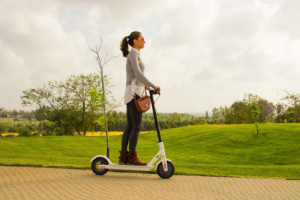Electric scooters are more environmentally friendly than traditional gas-powered vehicles, especially when charged with renewable energy sources.
Environmental Impact of Electric Scooter Production
Raw Material Sourcing and Sustainability
In the quest to understand the environmental footprint of electric scooters, a critical starting point is the sourcing of raw materials. Essential components like lithium for batteries, aluminum for frames, and rubber for tires predominantly dictate the sustainability of these vehicles. The extraction of lithium, often referred to as ‘white gold’, poses significant environmental challenges. According to the United States Geological Survey, the process can lead to soil contamination and depletion of local water resources. On the brighter side, companies are increasingly investing in sustainable mining practices, striving to minimize environmental harm. The use of recycled aluminum, which requires 95% less energy than new aluminum, is another positive trend. However, the rubber industry, often criticized for deforestation and biodiversity loss, still has a long way to go in terms of sustainability.
Manufacturing Process and Carbon Footprint
Shifting focus to the manufacturing process, it’s evident that the carbon footprint is a complex issue. Electric scooters, although less resource-intensive than cars, still contribute to greenhouse gas emissions during their production. A notable aspect is the energy-intensive process of battery manufacturing. As per a study by the International Journal of Environmental Research and Public Health, the production of a single electric scooter battery can emit up to 150 kg of CO2. Efforts to mitigate this include transitioning to renewable energy sources in factories and optimizing production processes for efficiency. Companies are also exploring innovative manufacturing techniques, like 3D printing, to reduce waste and energy consumption.
Lifespan and Durability of Electric Scooters
The lifespan and durability of electric scooters are pivotal in their overall environmental assessment. A scooter with a longer lifespan means fewer units need to be produced, thereby reducing the cumulative environmental impact. Modern electric scooters boast an average lifespan of 2-3 years, with some models extending up to 5 years with proper maintenance. The durability largely hinges on the quality of components and the engineering design. Advances in materials science, like the use of reinforced carbon fiber, enhance the durability of these scooters. It’s also crucial to consider the maintenance and repairability of these vehicles. Models designed for easy repair and modular upgrades can significantly extend their usable life, thereby diminishing their environmental impact over time.
While electric scooters offer a greener alternative to traditional transportation, their environmental friendliness is not without caveats. From the sourcing of raw materials to the production process and the lifespan of the scooters, each stage has its environmental impacts. Continuous improvements in sustainable practices, technological advancements, and responsible consumer behavior are essential to maximize the environmental benefits of electric scooters.
Electric Scooter Usage and Emissions
Comparison with Traditional Transportation Modes
Electric scooters represent a significant shift in urban mobility, often touted as a more eco-friendly option compared to traditional transportation modes. A crucial point of comparison is the carbon footprint. For instance, a gasoline-powered car emits approximately 271 grams of CO2 per kilometer. In stark contrast, electric scooters emit as low as 8 to 35 grams of CO2 per kilometer, depending on the electricity source, according to a study by the Environmental Science & Technology journal. This comparison becomes even more favorable when considering electric scooters in cities that predominantly use renewable energy sources. The versatility and ease of use of electric scooters also contribute to reduced traffic congestion, leading to lower overall urban emissions.
Carbon Emissions during Operation
When assessing carbon emissions during operation, electric scooters stand out for their efficiency. Unlike internal combustion engines, electric scooters do not emit CO2 during operation. Their emissions are indirect, stemming from the electricity used for charging. The carbon intensity of this electricity varies based on the energy mix of the grid. For instance, in regions heavily reliant on coal, the emissions are higher compared to areas using hydroelectric or wind energy. It is estimated that electric scooters charged on a coal-dominant grid emit around 100 grams of CO2 per kilometer, which is still significantly lower than most cars and motorcycles.
Energy Efficiency and Battery Performance
The heart of an electric scooter’s environmental friendliness lies in its energy efficiency and battery performance. Modern electric scooters achieve remarkable energy efficiency, often exceeding 70-100 Wh/km. This efficiency reduces the overall demand for electricity, diminishing the environmental impact. The performance and lifespan of batteries are also crucial. Currently, most electric scooters use lithium-ion batteries, known for high energy density and long life cycles. A typical electric scooter battery can last for 500 to 1000 charge cycles before its capacity diminishes significantly. Advancements in battery technology are continuously improving these figures, leading to longer life spans and higher efficiency.
The use of electric scooters, therefore, presents a compelling case for a more environmentally friendly mode of transportation, especially when compared to traditional vehicles. The key to maximizing their benefits lies in the continuous improvement of battery technology and a shift towards cleaner energy sources for electricity generation. By addressing these aspects, electric scooters can become an even more sustainable option for urban mobility.
End-of-Life Handling and Recyclability
Disposal of Electric Scooters
The disposal of electric scooters poses a significant environmental challenge, primarily due to their composite materials and electronic components. Effective disposal methods are essential to mitigate environmental harm. When an electric scooter reaches the end of its life, typically after 2-5 years of service, it must be dismantled properly. Components like the electric motor, frame, and tires can often be recycled. The process is not straightforward due to the variety of materials involved. For instance, the frame, usually made of aluminum or steel, is highly recyclable, with recycling processes achieving up to 90% energy savings compared to new material production, as noted by the Aluminum Association. In contrast, smaller plastic parts and electronic components require specialized recycling processes to recover valuable materials and prevent environmental contamination.
Battery Recycling and Reusability
Battery recycling and reusability are crucial in determining the environmental footprint of electric scooters. Lithium-ion batteries, the most common type in electric scooters, are both a valuable resource and an environmental hazard if not disposed of correctly. The recycling process involves extracting valuable materials like lithium, cobalt, and nickel. This process not only reduces the demand for new raw material extraction but also prevents the leaching of toxic substances into the environment. According to the Battery University, only about 5% of lithium-ion batteries are recycled globally, highlighting a significant area for improvement. Efforts are underway to improve battery recyclability, including designing batteries for easier disassembly and increasing the efficiency of recycling processes.
Environmental Impact of Decommissioned Scooters
The environmental impact of decommissioned scooters is a multifaceted issue. When not properly disposed of, these scooters can contribute to landfill waste and environmental pollution. The batteries, if not recycled, are particularly problematic due to their toxic and corrosive materials. The environmental impact can be significantly mitigated through responsible disposal practices. This includes not only recycling but also repurposing parts for other uses. For instance, motors and electronic components can find new life in other applications, extending their useful lifespan and reducing waste. Manufacturers and policymakers play a pivotal role in this process, as they can set standards for recyclability and encourage the development of a circular economy around electric scooters.
The end-of-life handling and recyclability of electric scooters are critical factors in their overall environmental impact. Proper disposal and recycling can significantly reduce their ecological footprint, making them a more sustainable option in the long run. It is imperative that manufacturers, consumers, and policymakers work together to improve the recyclability of these vehicles and close the loop in their life cycle.
Policy and Regulatory Frameworks
Government Policies on Electric Scooters
Government policies play a pivotal role in shaping the use and impact of electric scooters. These policies can either encourage or hinder their adoption. Many cities and countries have implemented regulations to ensure the safe and efficient operation of electric scooters. For example, in Paris, electric scooters are subject to speed limits of 20 km/h, and parking in designated areas is mandatory to avoid cluttering sidewalks. Sseveral governments are actively promoting electric scooters as part of their sustainable urban mobility plans. In countries like the Netherlands and Denmark, comprehensive cycling infrastructure is being adapted to accommodate electric scooters, demonstrating a commitment to eco-friendly transportation. Challenges remain, such as integrating scooters into existing traffic laws and ensuring rider safety.
Environmental Standards and Compliance
Adhering to environmental standards is critical for the sustainable operation of electric scooters. Manufacturers are increasingly required to comply with strict environmental regulations regarding the production and disposal of electric scooters. These standards often include limits on emissions during manufacturing, requirements for recyclable materials, and guidelines for battery disposal and recycling. The European Union, for instance, has implemented the Waste Electrical and Electronic Equipment Directive (WEEE Directive), which mandates the responsible disposal and recycling of electronic waste, including electric scooters. Compliance with such standards not only reduces the environmental impact of these vehicles but also drives innovation in sustainable manufacturing practices.
Incentives for Using Eco-Friendly Transport Options
Incentives are a powerful tool for promoting the use of eco-friendly transport options like electric scooters. Governments and local authorities are implementing various incentives to encourage people to choose greener modes of transportation. These incentives can take many forms, such as financial subsidies, tax breaks, or grants for purchasing electric scooters. For example, in California, the Clean Vehicle Rebate Project offers rebates for the purchase of eligible zero-emission vehicles, including electric scooters. Cities might also offer reduced or free parking fees for electric scooters, making them a more attractive option compared to cars. Some governments are investing in infrastructure improvements, such as dedicated scooter lanes, to enhance safety and convenience for electric scooter users.
In conclusion, the policy and regulatory frameworks surrounding electric scooters are complex and evolving. Governments play a crucial role in shaping the landscape for these eco-friendly vehicles, balancing the need for safety and order with the goal of reducing urban transportation’s environmental impact. By implementing thoughtful policies and incentives, authorities can significantly influence the adoption and sustainability of electric scooters in urban areas.

